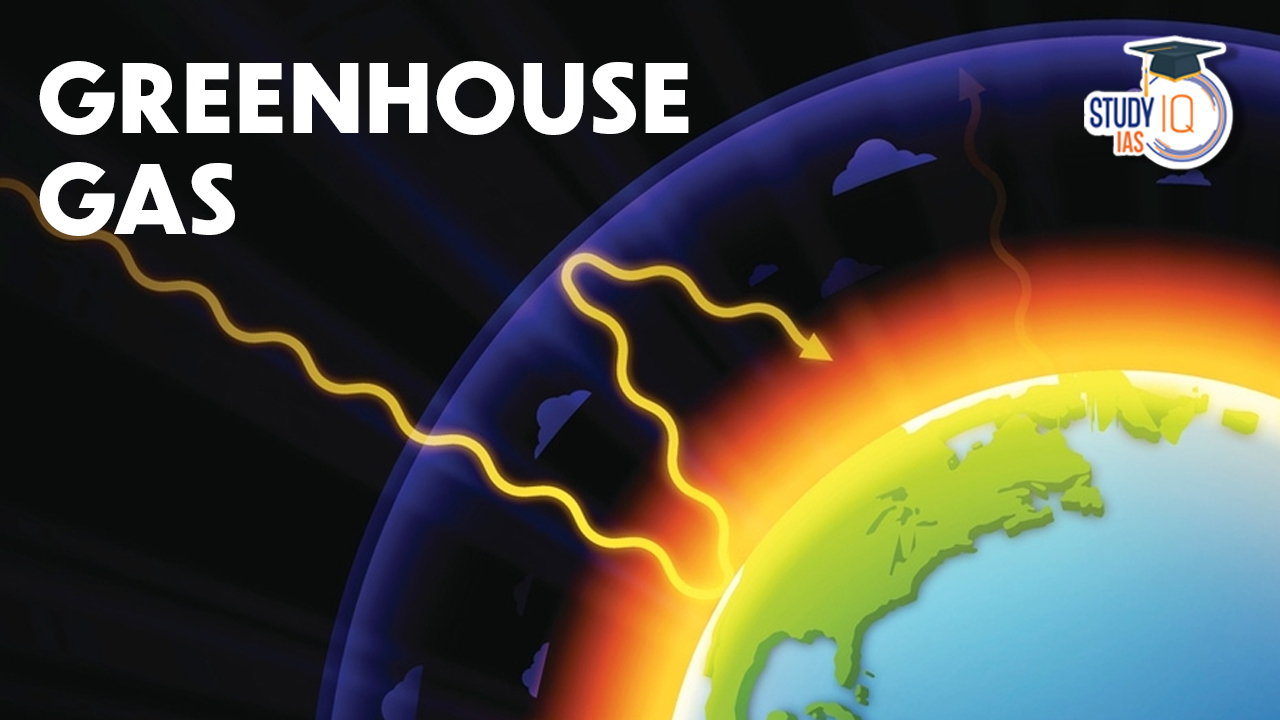Table of Contents
Greenhouse Gases
Greenhouse Gases are the gas due to which heat are being trapped into the atmosphere. They permit sunlight to penetrate the atmosphere, but they stop heat from escaping. Carbon dioxide, methane, nitrous oxide, hydrochlorofluorocarbons (HCFCs), hydrofluorocarbons (HFCs), and ozone are the main greenhouse gases found in the atmosphere. The greenhouse effect is caused by the ability of atmospheric gases such carbon dioxide, methane, nitrous oxide (N2O), water vapour, and chlorofluorocarbons to absorb incoming infrared radiation from the earth’s surface. As a result, the heating effect is known as the greenhouse effect, and these gases are referred to as greenhouse gases.
This topic of Greenhouse Gases is important from the perspective of UPSC IAS Examinations which falls under UPSC Syllabus of Environment. We will cover about the greenhouse gases in this article. We will gain knowledge of its main emission sources. We will also talk about how greenhouse gases contribute to climate change and global warming.
What are Greenhouse Gases ?
A greenhouse gas is a gas that both absorbs and emits infrared light. The greenhouse gases in the atmosphere absorb a sizeable percentage of the infrared radiation (long-wave energy) that the Earth’s surface emits, preventing it from leaving the Earth’s system. They also emit this infrared energy that has been absorbed back toward the earth’s surface. They aid in preserving the planet’s average surface temperature of 14 °C. Without the natural greenhouse effect, the Earth’s average surface temperature would be roughly -18°C. They have a considerable effect on the earth’s heat budget. Their abundance contributes significantly to affecting the world’s climate, which increases their significance. Some of the major Greenhouse Gases are
- Water Vapour
- Fluorinated gases (Synthetic)
- Chlorofluorocarbons (CFCs)
- Ozone
- Carbon dioxide
- Nitrous Oxide
- Methane
Detailed List of Greenhouse Gases
Similar principles govern how the greenhouse effect on Earth’s surface operates. Similar to a greenhouse’s glass roof, greenhouse gases and water vapor trap solar radiation that is being emitted from the sun. Thus, the earth’s temperature is increased by these greenhouse gases. The detailed list of Greenhouse Gases have been discussed below:
| Detailed List of Greenhouse Gases | |
| Greenhouse Gases | Details on Greenhouse Gases |
| Water vapour |
|
| Carbon dioxide (CO2) |
|
| Methane ( CH4 ) |
|
| Ozone ( O3) |
|
| Nitrous Oxide (N2O) |
|
| Chlorofluorocarbons (CFCs) |
|
| Carbon Monoxide |
|
| Brown Carbon |
|
Greenhouse Gases Sources and Emission
Check the Greenhouse Gases Sources and Emission as provided below:
Production of Electricity and Heat
Burning coal, oil, and natural gas is the single largest source of pollution, accounting for one-fourth of all emissions brought on by human activity globally. With around 27.5% of all emissions coming from it globally, it is the second-largest source of emissions after transportation.
Buildings
The production of energy on-site and the combustion of fuels for heating or cooking are the sources of this sector’s greenhouse gas emissions.
Industry
Approximately one-fifth of all emissions created by humans worldwide are attributed to the industrial sector, which includes the manufacture of goods and raw materials (such as cement and steel), food processing, and construction. As well as waste management activities, chemical, metallurgical, and mineral transformation processes also contribute to emissions in this sector.
Agriculture, forestry, and other land uses
These three land uses agriculture, forestry, and other land uses are the primary contributors to greenhouse gas emissions. This is true even if the carbon dioxide (CO2) that ecosystems take from the atmosphere and store in biomass, decomposing organic matter, and soils is not included in this sector.
Deforestation
Deforestation is another significant source of CO2. When trees are cut down for fuel or to create commodities, the carbon they normally store for photosynthesis is released. The World Resources Institute estimates that this process is responsible for up to 4.8 billion metric tons of carbon being released into the atmosphere each year.
Greenhouse Gases: Climate Change and Global Warming
The phenomenon of global warming and climate change is brought on by an increase of greenhouse gases in our atmosphere. The greenhouse effect, which ultimately results in global warming, is caused by greenhouse gases increasing the heat in the atmosphere.
Three criteria determine a greenhouse gas’s capacity to contribute to global warming: its GWP, which is a gauge of how much of it is present in the atmosphere at any particular time. The amount of greenhouse gases in the atmosphere has increased to hazardous levels in recent years. Over a 20,000-year era before the Industrial Revolution, atmospheric CO2 fluctuated between 180 parts per million (ppm) during ice ages and 280 ppm during gentle interglacial times. However, since the beginning of the Industrial Revolution in the 1750s, the amount of CO2 has increased by more than 50%. Since 1900, emissions of greenhouse gases other than CO2 have also considerably increased.
Because these greenhouse gases block outgoing terrestrial radiation, heat is trapped in the atmosphere and reflected back to the earth’s surface, where it is absorbed. The difference in how much heat enters and leaves the globe has been a significant contributor to global warming.
Greenhouse Gas and its Emission in India
According to India’s third Biennial Update Report, which was submitted to the United Nations Framework Convention on Climate Change (UNFCCC) in February 2021, the nation’s net greenhouse gas emissions for 2016 were 2.5 billion tonnes. India’s emissions from 1850 to 2019 were just approximately 4% of the total global emissions, while having about one-sixth of the world’s population. However, since 1990, GHG emissions have increased by 335 percent. After China and the US, India is currently the third highest emitter of greenhouse gases worldwide.
Thermal power stations, rice fields, and livestock are the main contributors to greenhouse gas emissions in India. According to the Center for Study of Science, Technology & Policy, emissions from coal-based power generation are anticipated to gradually decrease as a result of more effective recently developed technologies, like super-critical boilers for thermal power generation. Despite the fact that coal has remained a major source of electricity due to policies promoting economic development, increasing demand, and aspirations for development, the Center notes that coal has remained a major source of electricity.
- According to data from the World Resources Institute, India’s GDP increased 357% between 1990 and 2014, yet GHG emissions increased 180% during the same period.
- In terms of GHG emissions per unit of GDP in 2014, India outperformed the rest of the globe.
- In contrast, India pledged in its Intended Nationally Determined Contribution (INDC) to reduce GDP emissions intensity by 33-55% from 2005 levels by 2030. India has made significant progress toward establishing a low-carbon economy across a variety of sectors.
- Despite having an aggressive 40% non-fossil fuel capacity share objective, India is on track to greatly surpass its 2030 goals.
Greenhouse Gases Goals to Reduce Emissions
CO2, CH4, N2, hydrofluorocarbons (HFCs), perfluorocarbons (PFCs), and sulfur hexafluoride (SF6) were among the greenhouse gases that required reduction. United Nations Framework Convention on Climate Change: It was signed in 1992 and went into force in 1994 with the goal of “stabilising atmospheric greenhouse gas concentrations at a level that would prevent dangerous anthropogenic intervention with the climate system.” The Transportation and Climate Initiative (TCI), which is committed to developing a cap-and-invest program targeted at decreasing emissions from the transportation sector, will involve a large number of states.
- Increasing offshore wind power as well as onshore wind and solar energy.
- Improving manure processing to reduce emissions of methane from cattle.
- Soil and vegetation can store carbon through pilot projects for climate-friendly land use.
- Incentives to consume environmentally friendly foods and reduce food waste.
- An international agreement known as the Kyoto Protocol (KP) was approved in 1997 at the third COP. Its primary goal was to cut global greenhouse gas emissions by at least 5% by 2012 compared to 1990 levels.
- The World Meteorological Organization (WMO) and the United Nations Environment Programme (UNEP) formed the Intergovernmental Panel on Climate Change (IPCC) in 1988 to provide policymakers with periodic evaluations of the science underlying climate change, its consequences, and potential hazards.


 UPSC CDS 2 Result 2025 Declared at upsc....
UPSC CDS 2 Result 2025 Declared at upsc....
 UPSC to Release Provisional Answer Key A...
UPSC to Release Provisional Answer Key A...
 UPSC NDA 2 Result 2025 OUT – Download ...
UPSC NDA 2 Result 2025 OUT – Download ...




















